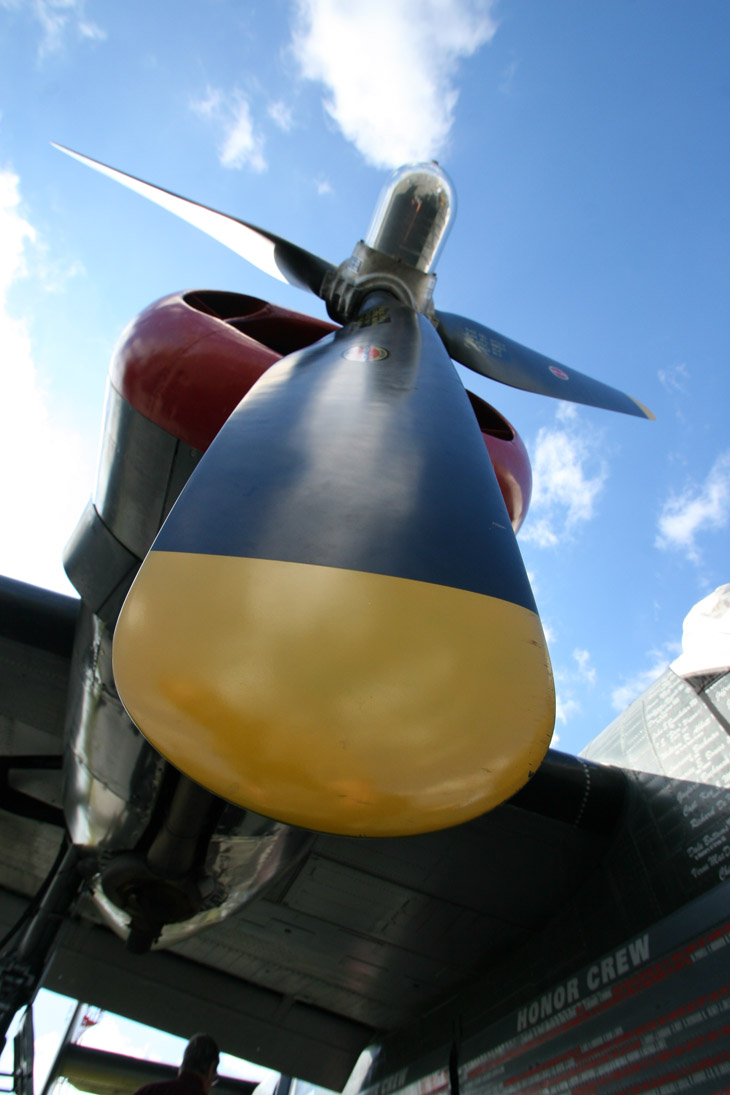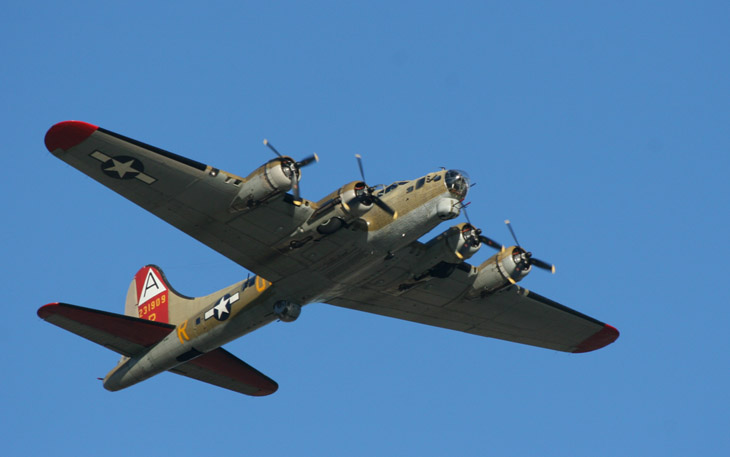
Okay, I’m finally getting to this!
Several days back, the Wings of Freedom tour from the Collings Foundation made its visit to nearby Raleigh-Durham International Airport (RDU,) and the Immaculate Mr Bugg and I paid a visit. The Collings Foundation is a non-profit organization that restores and maintains vintage military aircraft, and there were four classic WWII planes that they were flying between stops of the tour: a Boeing B-17G Flying Fortress (seen above,) a Consolidated B-24J Liberator, a North American B-25 Mitchell, and a North American TF-51D Mustang. The latter is a pursuit/fighter (technically a trainer,) while the other three are bombers. As I mentioned earlier, the modest admission cost of $15 allowed visitors to not only walk around all of the aircraft, but to take a walk-through of the bomber interiors as well, which is actually a pretty good deal – it’s not often that you get the opportunity to see the workings of a warbird in person. Many years ago in my active modelmaking days, I had built a kit of the B-17G, a 1/48th scale model available from Monogram, that included fairly elaborate interior detail, so I was already somewhat familiar with the layout, but jumped at the opportunity to see the real thing. And the most prominent takeaway from the experience is that these aircraft were, shall we say, snug.
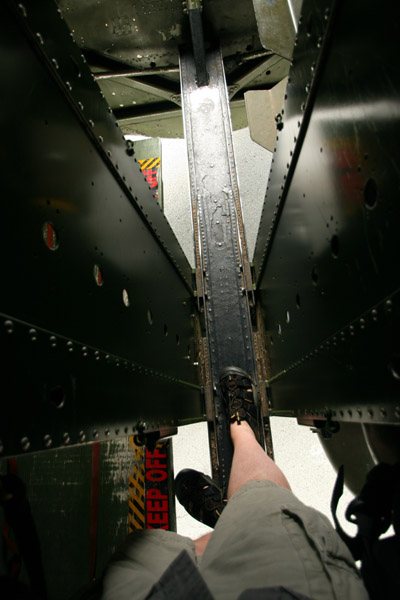 This is a view down at the catwalk through the middle of the (open) bomb bay of the “909,” the call sign of this particular B-17G, and yes, it’s only wide enough for one foot at a time. My main camera bag, a holster-style with two attached lens cases, was too wide to fit between the supporting frames of that catwalk, and it had to be turned sideways. To get here, one has to clamber awkwardly into the forward hatch, using something between a tight crouch and a crawl, then pass through the top-turret gunner’s mount that was stationed immediately before the forward bomb bay access door – those quarters were too cramped to actually allow any decent photos of this. The top-turret had a superstructure for the guns and turning motors, plus a platform that the gunner stood upon, and getting between these required crawling – I actually had to pull my knees through by hand to get them onto the catwalk, since they no longer will bend that tightly and readily on their own power. The only saving grace that I can offer about such tight access is that the crew almost never had to pass through the bomb bay during normal operations.
This is a view down at the catwalk through the middle of the (open) bomb bay of the “909,” the call sign of this particular B-17G, and yes, it’s only wide enough for one foot at a time. My main camera bag, a holster-style with two attached lens cases, was too wide to fit between the supporting frames of that catwalk, and it had to be turned sideways. To get here, one has to clamber awkwardly into the forward hatch, using something between a tight crouch and a crawl, then pass through the top-turret gunner’s mount that was stationed immediately before the forward bomb bay access door – those quarters were too cramped to actually allow any decent photos of this. The top-turret had a superstructure for the guns and turning motors, plus a platform that the gunner stood upon, and getting between these required crawling – I actually had to pull my knees through by hand to get them onto the catwalk, since they no longer will bend that tightly and readily on their own power. The only saving grace that I can offer about such tight access is that the crew almost never had to pass through the bomb bay during normal operations.
By the way, I was fairly spry compared to some of the WWII veterans that were on hand and touring the aircraft themselves, but they were still gamely maneuvering through the confines. I was happy to provide a little assistance to one gentleman ahead of me that had to scoot through that ridiculous space in the top-turret gunner’s position. As expected, there were more than a few vets on hand, but I think I only saw two that had actually served on these aircraft – it’s been a long time now, and not many are left.
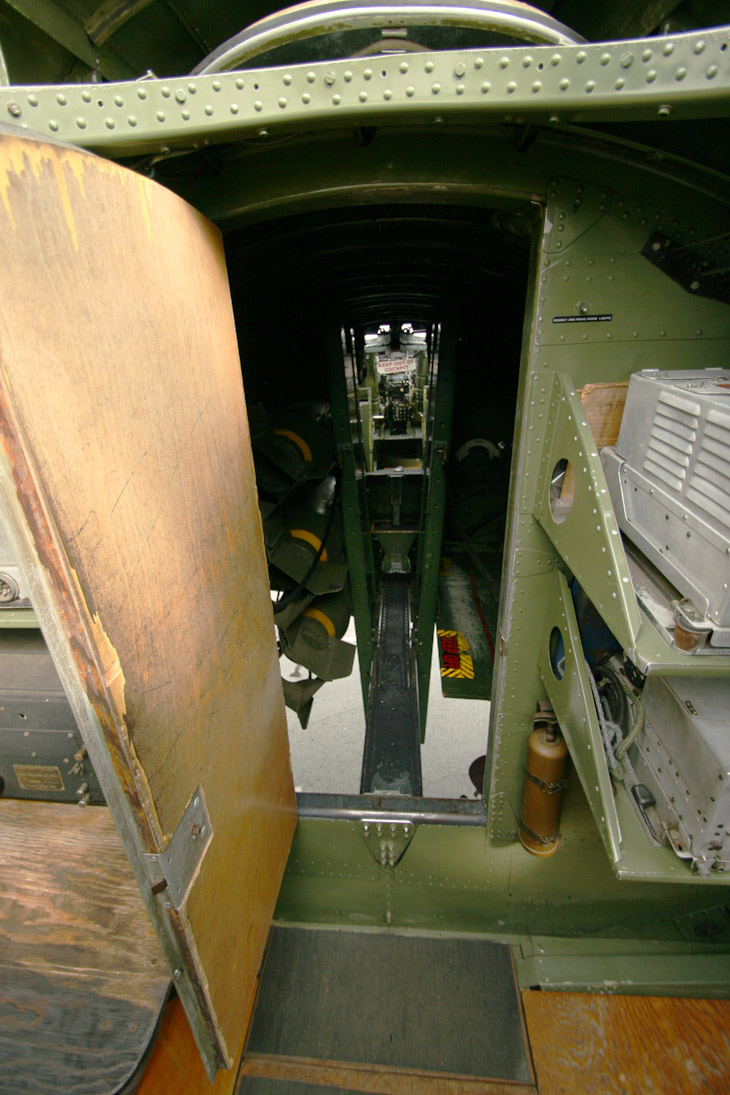
Above is a view from the radio station looking forward through the bomb bay towards the cockpit. The door is only half-height, and you can make out that same catwalk that cuts through the middle of the bomb bay between the racks, with the tail fins of some display bombs visible. The bright spot ahead is the cockpit, to which access was denied, but in between the bomb bay and the cockpit is the top-turret gunner’s station and the actual forward crew hatch to the plane. Below and between the pilots’ chairs, not really visible, is the path to the stations for the bombardier and navigator in the nose, while we’re looking through the top-turret gunner’s station; there is a pair of grey ‘wings’ just above the sign keeping us from the cockpit that is the shoulder brace for the gunner, while just out of sight below the lip of the far doorway is the rotating platform that the gunner stands on.
Also of note: at the top edge of the photograph you can see the silvery lip of the stowed window/hatch that formed the ceiling of the radioman’s station, and I am aiming downwards with the camera because, standing upright, my head poked out of the open hatch. Though this particular plane wasn’t so adorned, normally the window mounted a .50 caliber machine gun aiming upwards, which meant that firing it would require a crouching or kneeling position. Duty in these planes wasn’t a luxurious experience, but when the crew was trying to fend off attacking fighters, I doubt much attention was paid to the awkwardness of the position.
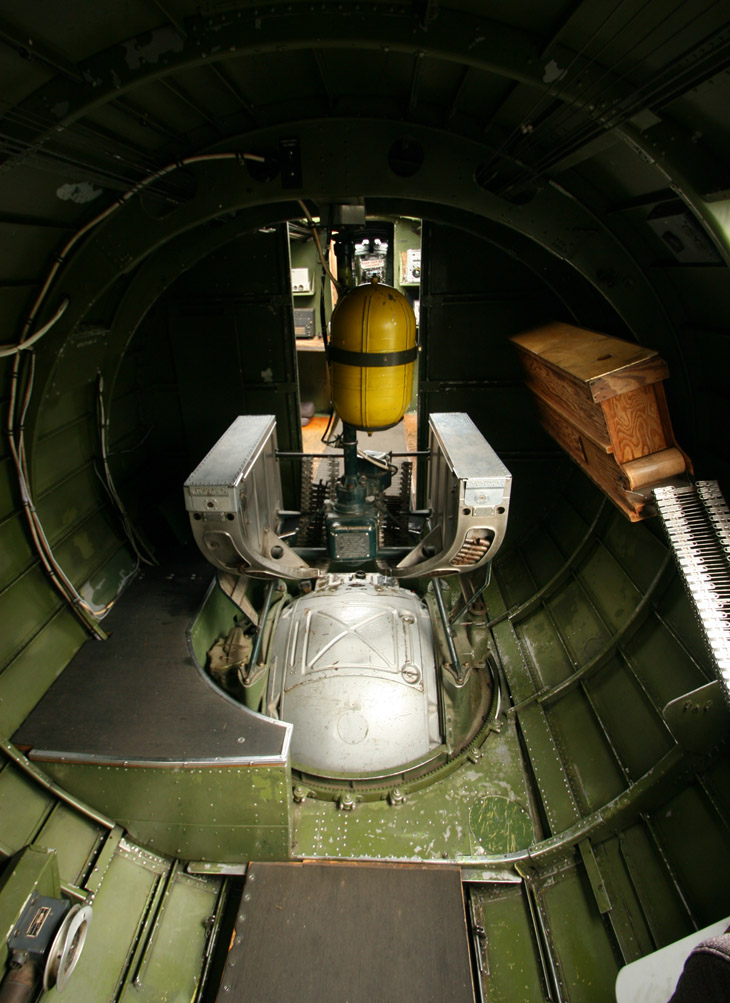
Further aft, we’re looking forward from the waist-gunner’s positions towards the radio station beyond that door, above and behind the belly-mounted ball turret – this wasn’t opened for inspection or ‘tours,’ but there was no way in hell I could possibly have fit in there anyway. It’s the round thing in the bottom of the frame, and the walkway around it can be seen on the left side, another tight squeeze. The cross section of the fuselage at this point was probably 2.5 meters or so. The big grey boxes hanging above are ammunition supply; the B-17G sported thirteen .50 caliber machine guns, two of which resided within this turret (with two more in the waist positions immediately behind me – another wooden ammo box and feed chute is seen to the right.) I couldn’t make out how the ammo actually entered the turret, but I know it had to be pretty flexible to allow for the emplacement’s range of motion.
Scattered throughout the plane were larger yellow tanks, seen here, and smaller green tanks often nearby. To the best of my knowledge, the yellow tanks were compressed air, the normal mix that we breathe of about 80% nitrogen and 19% oxygen, while the smaller tanks were supplemental pure oxygen – those colors are in current use at least. Since I have found no source to confirm this supposition yet, don’t quote me.
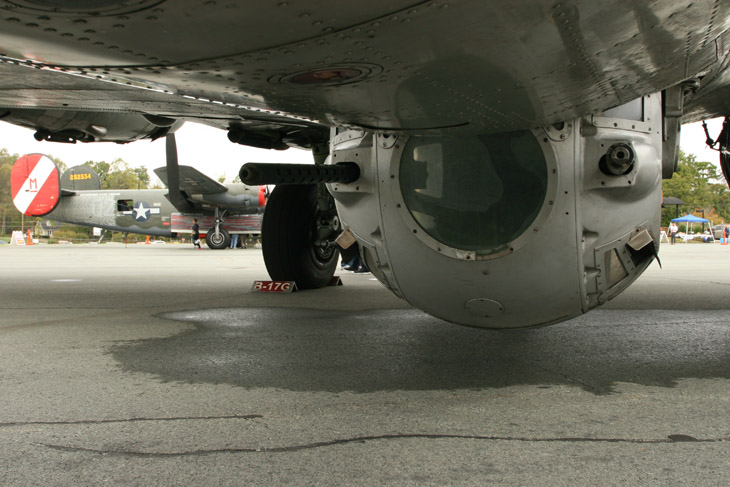
Here’s the exterior view of the turret – I’m sitting on the ground to get this perspective. Bear in mind that these planes weren’t heated in any way, and operated at high altitudes most of the time – flights were cold. Those fur-lined bomber jackets were an absolute necessity, and out here, exposed to the wind blast with only a thin layer of aluminum for shielding, the position was without a doubt hugely uncomfortable. I imagine that you learned quickly never to touch the bare metal with exposed skin…
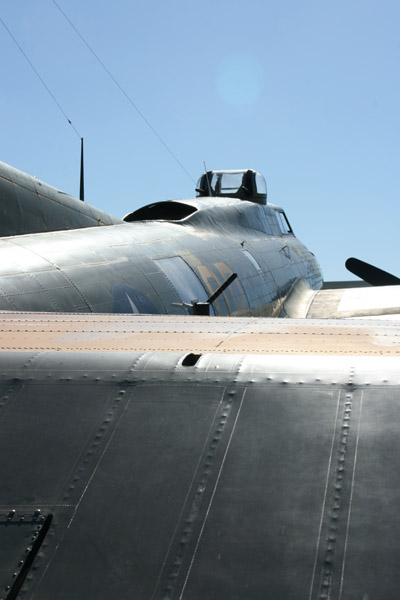 This is the first of my fartsy compositions, shooting over the horizontal stabilizer (tail plane) of the B-17G towards the nose, showing the starboard waist gunner’s emplacement and the open hatch over the radio station, with the top turret in view beyond. Notice how the waist gunner station is enclosed, with the gun projecting through a gimbal-mount port; this was a new addition to the G model, and earlier models (and the B-24J Liberator seen in the background of the pic above) had open windows. Freaking frigid operations in those.
This is the first of my fartsy compositions, shooting over the horizontal stabilizer (tail plane) of the B-17G towards the nose, showing the starboard waist gunner’s emplacement and the open hatch over the radio station, with the top turret in view beyond. Notice how the waist gunner station is enclosed, with the gun projecting through a gimbal-mount port; this was a new addition to the G model, and earlier models (and the B-24J Liberator seen in the background of the pic above) had open windows. Freaking frigid operations in those.
I’ll take a moment and some empty space here to add in a few details. We initially saw two of the bombers, the B-17G and the B-24J, on the first day of their visit to RDU, which is where this pic was taken, but the B-25 and the TF-51D were late in arriving, and didn’t actually get there until after we left. RDU was crowded and the line to enter this particular plane was long, but the B-24J had been out on an air tour when we arrived and landed within the hour, so I hopped in the new line to pass through that one once it had taxied in and parked. Soon afterward, they cut off the line for the B-17G because it was going on an air tour of its own, so I never got to view the interior then. I had planned on returning two days later, but an illness prevented me from attempting it (it’s not a good idea to go out on an airport apron far from ‘facilities’ when you have a stomach bug.) However, the Wings of Freedom Tour had Burlington Regional Airport as its next stop, barely a 20 minute hop from RDU and not even twice that by car from where I live, so I caught them there not quite a week after my first visit, and all of the interior shots seen here were from that portion. I was happy to pay admission twice, and Burlington wasn’t crowded at all, so I could take more time without holding up people behind me.
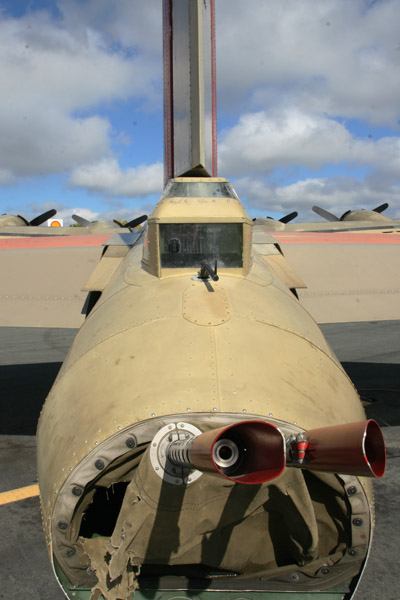 Moving just a bit further back and to the left, we have the tail gunner’s position; the fuselage has narrowed so much at this point that it’s just wide enough for someone to fit in there, and the sighting windows for the guns are not a whole lot more than a helmet. My interior access to this point was also denied – it actually stopped at the rear crew hatch that exists just behind the USAAF insignia and under the tail plane in the pic above. Most likely, between the tight quarters that people would have to back out of and the need for clambering around the tailwheel structure, it was deemed just too much of a risk and hassle.
Moving just a bit further back and to the left, we have the tail gunner’s position; the fuselage has narrowed so much at this point that it’s just wide enough for someone to fit in there, and the sighting windows for the guns are not a whole lot more than a helmet. My interior access to this point was also denied – it actually stopped at the rear crew hatch that exists just behind the USAAF insignia and under the tail plane in the pic above. Most likely, between the tight quarters that people would have to back out of and the need for clambering around the tailwheel structure, it was deemed just too much of a risk and hassle.
By the way, if you want a few more pics and a nice overall diagram of the crew positions and layout, this page does an excellent job. It’s a different aircraft but the same model, with only trivial differences in the equipment. And Air & Space Magazine online has another collection of interior photos. Overall, there were ten crewmembers in a B-17: pilot, copilot, navigator, bombardier, engineer/top gunner, radio operator, ball turret gunner, 2 waist gunners, and a tail gunner. Of those, only the pilots didn’t have guns at their positions – the bombers were, unsurprisingly, prime targets for defending aircraft, and for most of the war they had a much greater range than any escort fighters that the allies could field, so they often had to fly alone far into hostile airspace, and even with all of the guns they were easy prey for agile fighters. Feel free to do a search on damaged WWII bombers – there are more pics than you can imagine, and these are generally the ones that safely made it back. Thousands didn’t.
We need a look at the nose.

The G model added in that big gun turret and the two guns to either side of the nose; earlier models just had one straight out the front. Visible here behind the flat sheet of plexiglass is the Norden bombsight, an ingenious mechanical targeting computer that actually flew the plane onto the chosen target when it got close – the bombardier’s job was to ensure that the settings remained correct and the crosshairs remained aligned with the target. Above that near the top of the nose cone sits the aiming rig for the chin turret, and to the left running behind that little round port window sits the swing-away controls for the same turret. You can see a round window showing sky further back; that’s the navigator’s dome for doing celestial navigation, of which a greater explanation can be found here. The bombardier had control of the chin turret, while the navigator could man the two guns flanking the nose.

Here’s another shot showing the nose art and the line to see the interior at RDU, and I apologize for the quality – I inadvertently had exposure compensation turned up from a previous shot, and this was the only photo I have showing the nose art clearly, so I tweaked it in editing. The forward crew hatch, through which the interior tours began, can be seen at lower center – the ladder was a courtesy to us civilians, since the normal aircrews never used them. You had to clamber in practically underneath the copilot’s seat and dodge aft a bit just to stand up in the narrow space between the pilots’ chairs and the top-turret station, before crawling through the same station to get into the bomb bay (you can see the open doors of the bay under the engine nacelle.) The boomerang antenna just ahead of the navigator’s dome is a modern addition I think, not part of the original model’s complement, but instead in support of current avionics.
The nose art is most likely fictional – very few WWII aircraft in this country ever saw combat, since when the war ended there was no reason to bring most of them back, so what are typically seen are trainers, rebuilds, and late-production aircraft that never actually got shipped out of the states, though there are a few notable exceptions (the Foundation’s B-24J being one of them, but more about that in another post.) This side of the plane shows the kind of nose art that might have been seen on a veteran aircraft, but the opposite side is liberally covered with the names of the big donors that help support the restoration and maintenance of these warbirds.
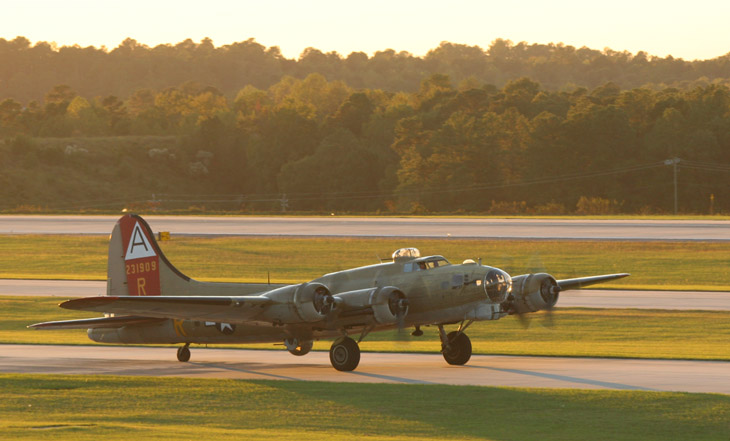
I did not neglect my overall views, and like this one best, taken as the 909 taxied in near sunset following an air tour – the same one that it is departing for in the image that opens this post, if I have my timing right. Between the ‘R’ and the insignia on the rear fuselage you can just make out a small window, more visible in the very first pic – that’s where the rear crew hatch is. And if you compare the propellers in the two images you can see the difference in light and its affect on shutter speed, because they’re spinning slower for this image than while climbing out up top, but blurred more here (I probably should have dropped the shutter speed a tad for the top pic, because they look better with a bit of blur.)
There’s another post coming, featuring the other aircraft, a lot more fartsy shots, and even some video. Give me a little more time – this one turned out long enough just concentrating on the B-17G.
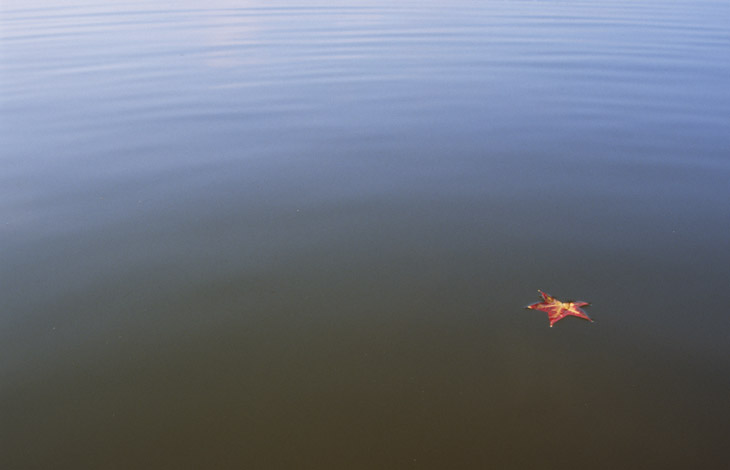





















































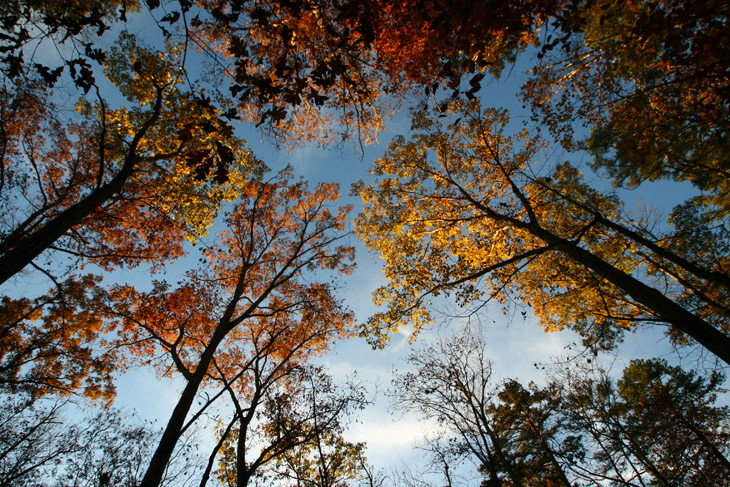
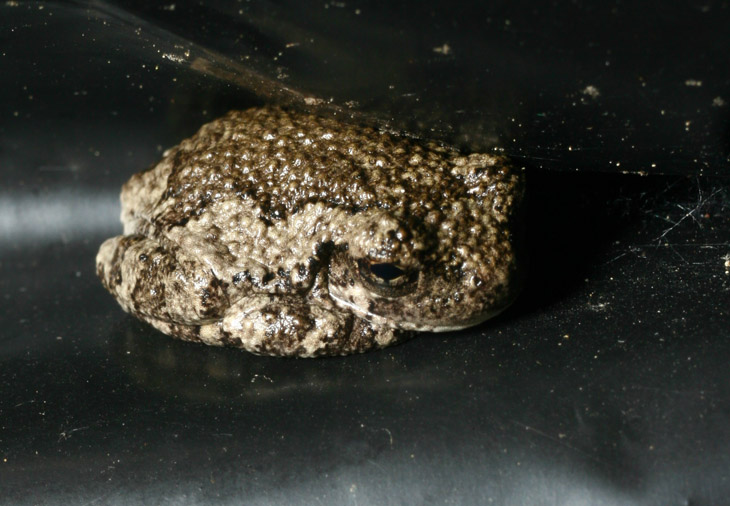
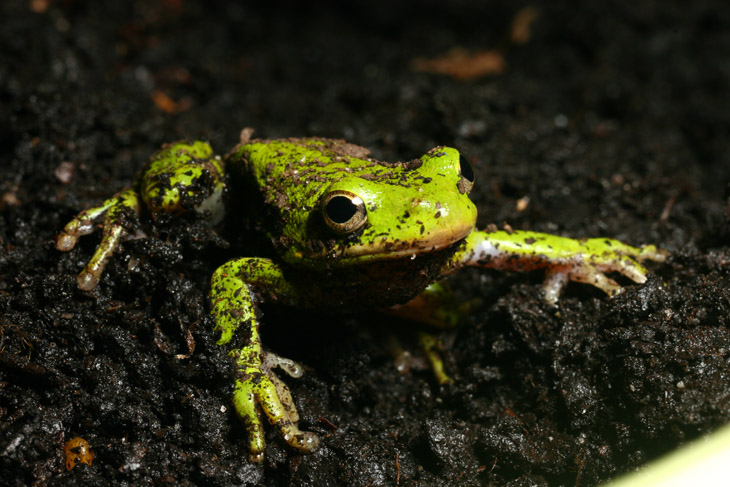
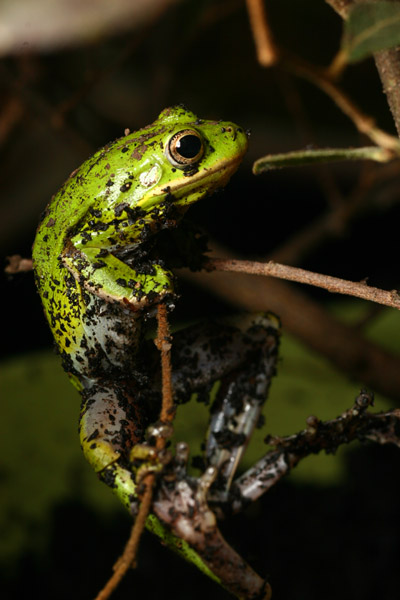 I quickly moved it to a safe location so we could continue our chores, but knew I’d be back to do a couple of photos. When I eventually returned, it had taken up a sleeping position against a rainbarrel, but I attempted to convince it to settle into the pot of the newly-transplanted bush, even very gently burying it to give it the idea – it was having none of this, and was making the effort to leave us well behind. After the images, we let it be and so have no real idea where it got itself off to, but I expect that we’ll see it again come spring, when perhaps it will have forgiven us. Or perhaps not. You know frogs and grudges.
I quickly moved it to a safe location so we could continue our chores, but knew I’d be back to do a couple of photos. When I eventually returned, it had taken up a sleeping position against a rainbarrel, but I attempted to convince it to settle into the pot of the newly-transplanted bush, even very gently burying it to give it the idea – it was having none of this, and was making the effort to leave us well behind. After the images, we let it be and so have no real idea where it got itself off to, but I expect that we’ll see it again come spring, when perhaps it will have forgiven us. Or perhaps not. You know frogs and grudges.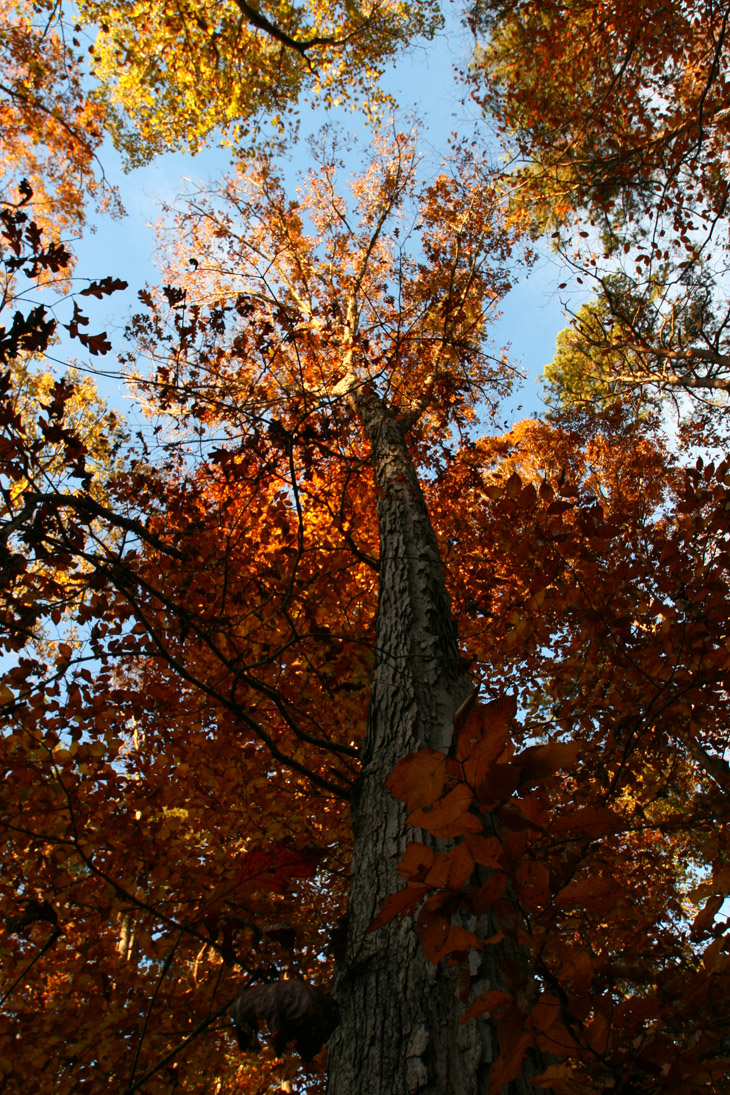
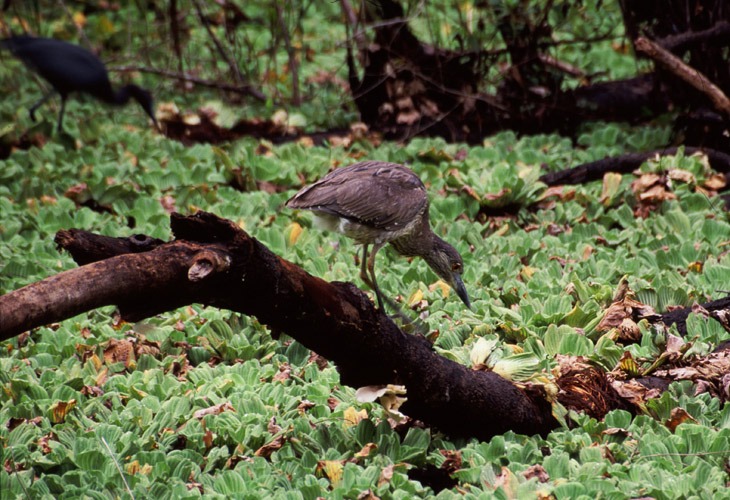

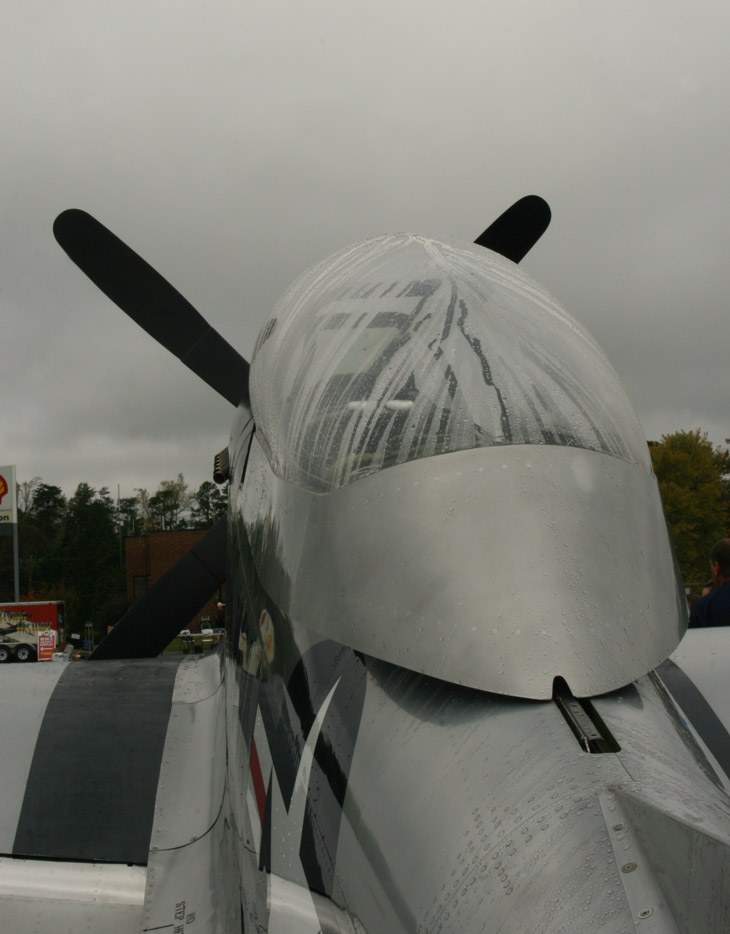
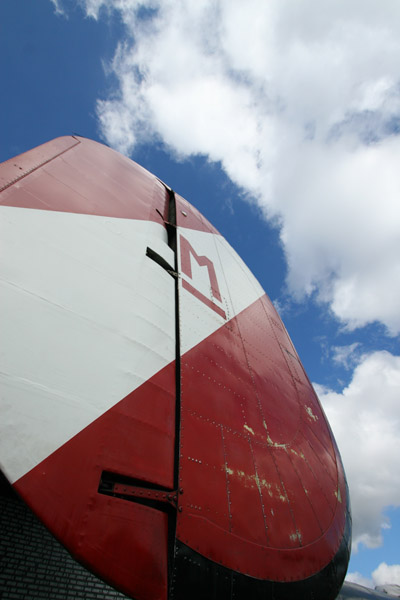 The day did indeed clear, so I have a nice mix of conditions from the Burlington session, but you’ll see shots from both – more fartsy stuff this time around, because I was experimenting a bit. This is the tail fin of the B-24J Liberator “Witchcraft,” which you’ve seen
The day did indeed clear, so I have a nice mix of conditions from the Burlington session, but you’ll see shots from both – more fartsy stuff this time around, because I was experimenting a bit. This is the tail fin of the B-24J Liberator “Witchcraft,” which you’ve seen 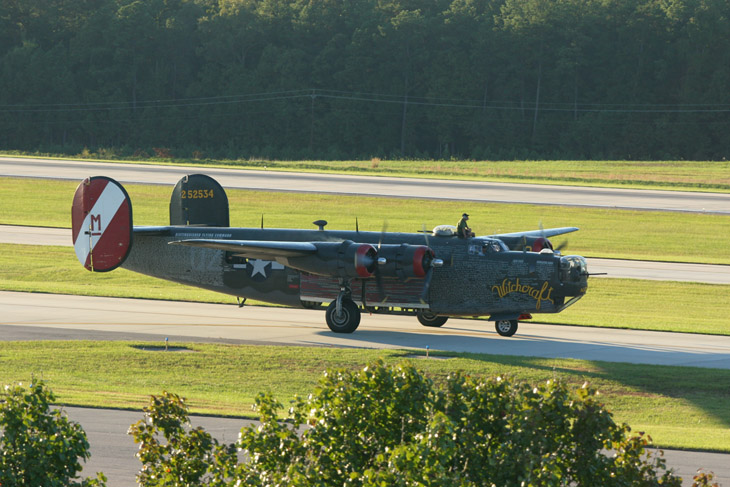

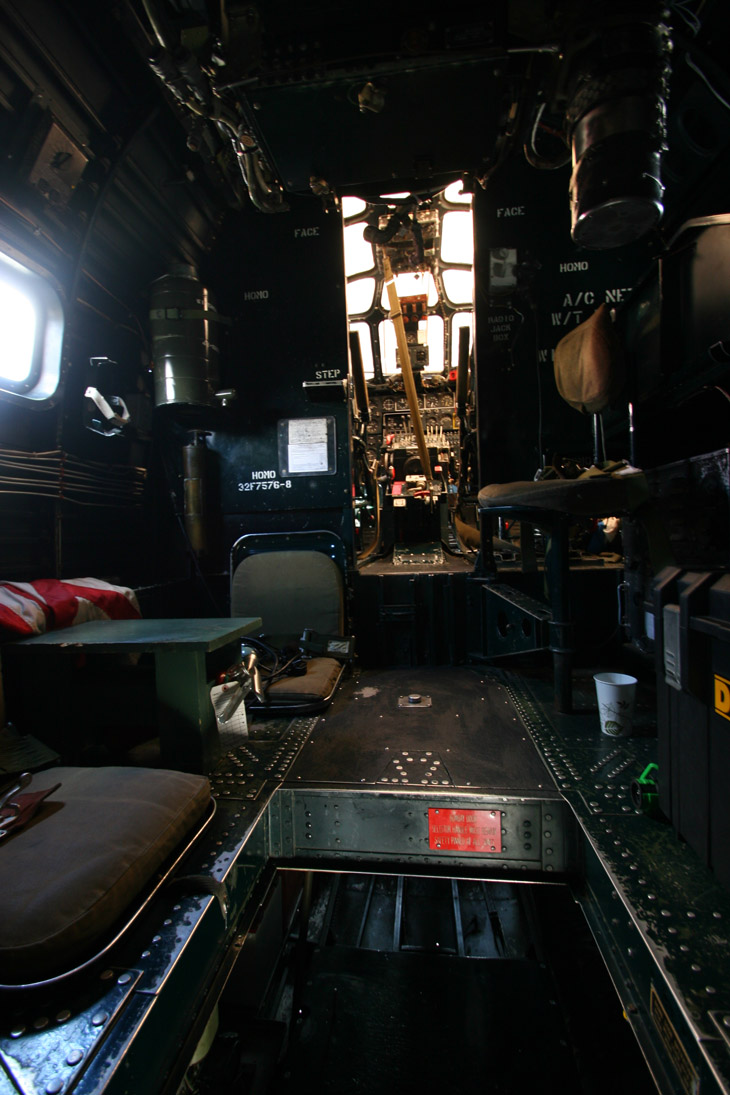
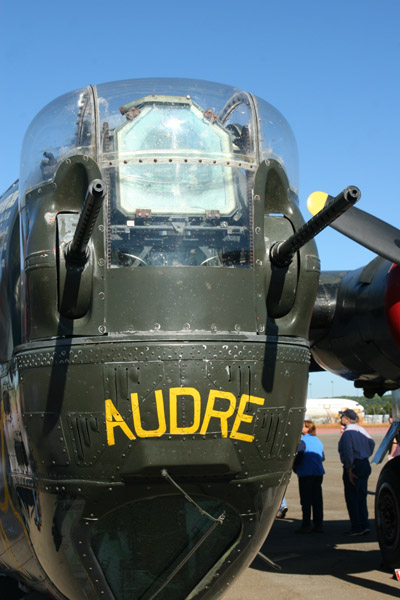 Above is a view of the interior of the B-24J, from the bomb bay looking forward; the bright area is the flight deck, while the immediate surroundings are the realm of the engineer (and top gunner) and radio operator. Further forward is the compartment that housed the navigator, bombardier, and nose-turret gunner – that hatch in the lower foreground allowed a tight access under the deck to the area, which sat below and in front of the flight deck. Using this access would have required one to crawl past the nose wheel, and I believe that the crew normally entered that section through the nose gear doors instead – still a tight squeeze. This area was closed off to visitors, so I simply poked the camera through the netting.
Above is a view of the interior of the B-24J, from the bomb bay looking forward; the bright area is the flight deck, while the immediate surroundings are the realm of the engineer (and top gunner) and radio operator. Further forward is the compartment that housed the navigator, bombardier, and nose-turret gunner – that hatch in the lower foreground allowed a tight access under the deck to the area, which sat below and in front of the flight deck. Using this access would have required one to crawl past the nose wheel, and I believe that the crew normally entered that section through the nose gear doors instead – still a tight squeeze. This area was closed off to visitors, so I simply poked the camera through the netting.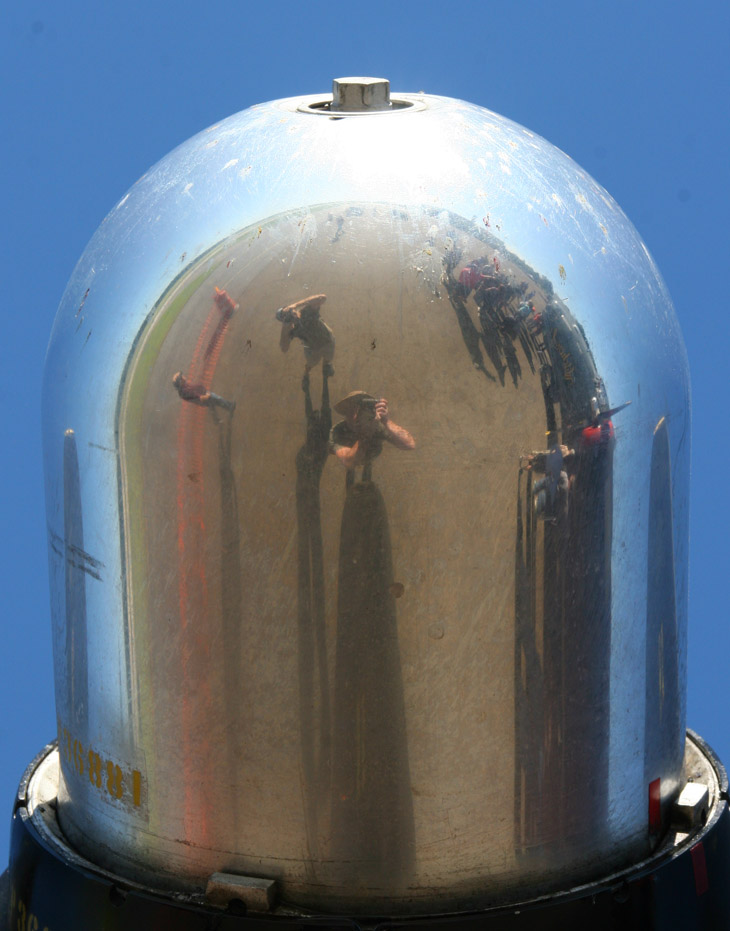
 A couple of very similar fartsy shots, as the weather at Burlington cleared up and became pleasant. The one to the left is the horizontal and vertical stabilizers (tail plane and rudder) of the B-17G “909” – it’s easy to see that the plane’s name came from the serial number, the other markings identify the bomber group and squadron, in this case the 91st Bomber Group (‘A’ in triangle) and 323rd Squadron (‘R’) within that group. High visibility markings permitted quick identification of aircraft for rendezvous, such as with fighter escorts or multiple squadrons meeting for the same mission. I incorrectly surmised in part 1 that the markings were fictional – I should have checked my pics of the placard that accompanied the plane, because it clearly says they’re based on a real aircraft that completed 140 missions without a loss of crewmember! This is, alas, not the same plane, which was eventually scrapped, but a stateside model later restored as a replica of a combat aircraft.
A couple of very similar fartsy shots, as the weather at Burlington cleared up and became pleasant. The one to the left is the horizontal and vertical stabilizers (tail plane and rudder) of the B-17G “909” – it’s easy to see that the plane’s name came from the serial number, the other markings identify the bomber group and squadron, in this case the 91st Bomber Group (‘A’ in triangle) and 323rd Squadron (‘R’) within that group. High visibility markings permitted quick identification of aircraft for rendezvous, such as with fighter escorts or multiple squadrons meeting for the same mission. I incorrectly surmised in part 1 that the markings were fictional – I should have checked my pics of the placard that accompanied the plane, because it clearly says they’re based on a real aircraft that completed 140 missions without a loss of crewmember! This is, alas, not the same plane, which was eventually scrapped, but a stateside model later restored as a replica of a combat aircraft. 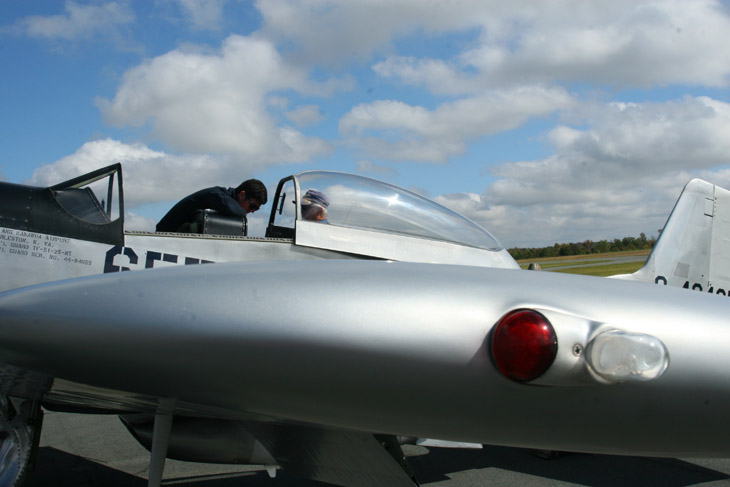
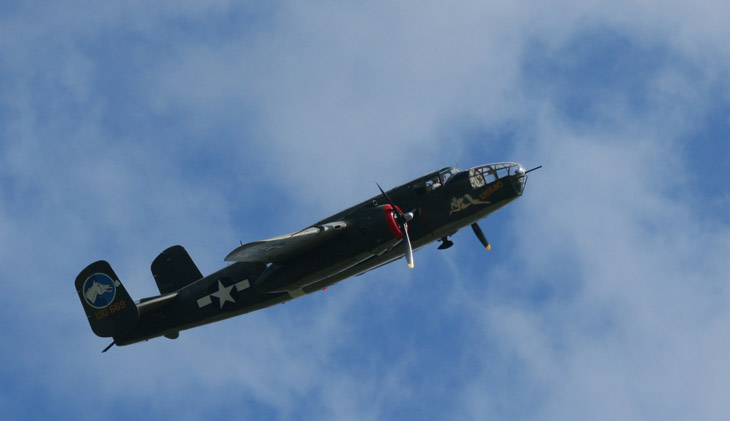
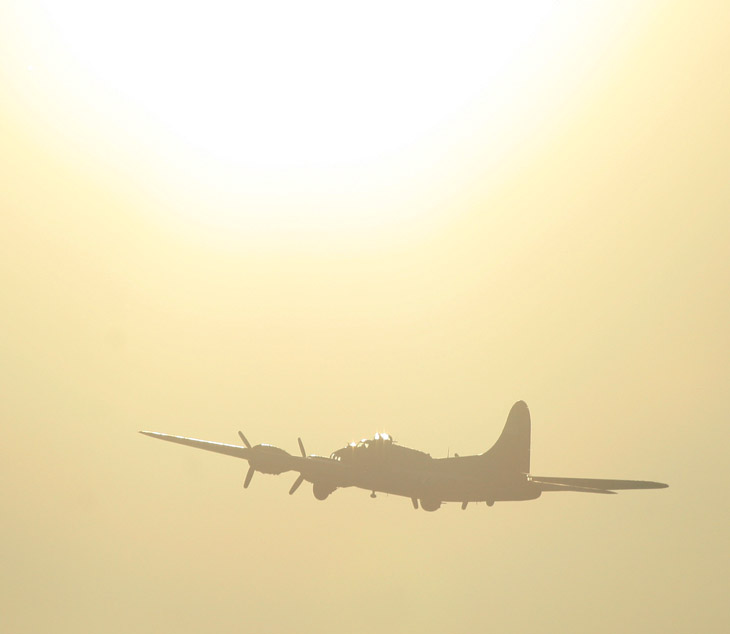



 This is a view down at the catwalk through the middle of the (open) bomb bay of the “909,” the call sign of this particular B-17G, and yes, it’s only wide enough for one foot at a time. My main camera bag, a holster-style with two attached lens cases, was too wide to fit between the supporting frames of that catwalk, and it had to be turned sideways. To get here, one has to clamber awkwardly into the forward hatch, using something between a tight crouch and a crawl, then pass through the top-turret gunner’s mount that was stationed immediately before the forward bomb bay access door – those quarters were too cramped to actually allow any decent photos of this. The top-turret had a superstructure for the guns and turning motors, plus a platform that the gunner stood upon, and getting between these required crawling – I actually had to pull my knees through by hand to get them onto the catwalk, since they no longer will bend that tightly and readily on their own power. The only saving grace that I can offer about such tight access is that the crew almost never had to pass through the bomb bay during normal operations.
This is a view down at the catwalk through the middle of the (open) bomb bay of the “909,” the call sign of this particular B-17G, and yes, it’s only wide enough for one foot at a time. My main camera bag, a holster-style with two attached lens cases, was too wide to fit between the supporting frames of that catwalk, and it had to be turned sideways. To get here, one has to clamber awkwardly into the forward hatch, using something between a tight crouch and a crawl, then pass through the top-turret gunner’s mount that was stationed immediately before the forward bomb bay access door – those quarters were too cramped to actually allow any decent photos of this. The top-turret had a superstructure for the guns and turning motors, plus a platform that the gunner stood upon, and getting between these required crawling – I actually had to pull my knees through by hand to get them onto the catwalk, since they no longer will bend that tightly and readily on their own power. The only saving grace that I can offer about such tight access is that the crew almost never had to pass through the bomb bay during normal operations.


 This is the first of my fartsy compositions, shooting over the horizontal stabilizer (tail plane) of the B-17G towards the nose, showing the starboard waist gunner’s emplacement and the open hatch over the radio station, with the top turret in view beyond. Notice how the waist gunner station is enclosed, with the gun projecting through a gimbal-mount port; this was a new addition to the G model, and earlier models (and the B-24J Liberator seen in the background of the pic above) had open windows. Freaking frigid operations in those.
This is the first of my fartsy compositions, shooting over the horizontal stabilizer (tail plane) of the B-17G towards the nose, showing the starboard waist gunner’s emplacement and the open hatch over the radio station, with the top turret in view beyond. Notice how the waist gunner station is enclosed, with the gun projecting through a gimbal-mount port; this was a new addition to the G model, and earlier models (and the B-24J Liberator seen in the background of the pic above) had open windows. Freaking frigid operations in those. Moving just a bit further back and to the left, we have the tail gunner’s position; the fuselage has narrowed so much at this point that it’s just wide enough for someone to fit in there, and the sighting windows for the guns are not a whole lot more than a helmet. My interior access to this point was also denied – it actually stopped at the rear crew hatch that exists just behind the USAAF insignia and under the tail plane in the pic above. Most likely, between the tight quarters that people would have to back out of and the need for clambering around the tailwheel structure, it was deemed just too much of a risk and hassle.
Moving just a bit further back and to the left, we have the tail gunner’s position; the fuselage has narrowed so much at this point that it’s just wide enough for someone to fit in there, and the sighting windows for the guns are not a whole lot more than a helmet. My interior access to this point was also denied – it actually stopped at the rear crew hatch that exists just behind the USAAF insignia and under the tail plane in the pic above. Most likely, between the tight quarters that people would have to back out of and the need for clambering around the tailwheel structure, it was deemed just too much of a risk and hassle.


